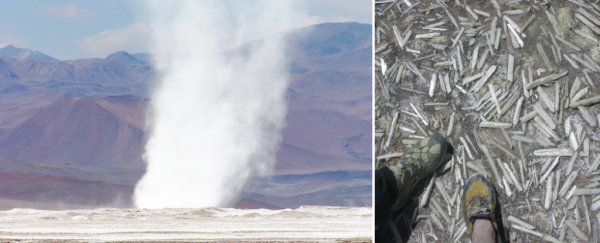Scientists have identified what could be a new form of whirlwind high up in the Andes Mountains, and not only do their size and strength challenge current records - they could explain the mysterious mounds of crystals that keep appearing on the dunes.
These crystals, which can grow up to 27 cm (10.6 inches) long, pile up in mounds several kilometres from where they formed, and researchers say only the strongest twisters on the planet could actually get them there.
High up in the Andes, on the border between Chile and Argentina, is a place called Salar de Gorbea, which is unlike any other region on Earth.
It's barren and virtually rainless, and its sands are winking with countless gypsum crystals that appear in perfectly formed mounds across the landscape.
That this stretch of desert is littered with giant shards of milky white crystals is weird enough, but that's not even the half of it. These crystals form in volcanic pools of acidic, salty water up to 5 km (3 miles) away from where they end up.
So how do these hefty, far-flung shards arrive in such great numbers, the sands of Salar de Gorbea appear carpeted with them?
 Crystal carpet. Credit: Kathleen Benison
Crystal carpet. Credit: Kathleen Benison
 Crystal mounds. Credit: Kathleen Benison
Crystal mounds. Credit: Kathleen Benison
Kathleen Benison, a geologist from West Virginia University, was studying the crystals in the area, when she noticed a massive white twister blasting through a valley several kilometres from where she was standing.
During her three-day visit to the Salar de Gorbea, she saw these twisters appear every afternoon, and watched them lurch from the valley of crystal pools to dunes above, before promptly dissipating.
She nicknamed them gravel devils - a form of dust devil, which is a weak, long-lasting whirlwind.
"I remember holding one of the crystals and noticing how they were all broken," Benison told Joanna Klein at The New York Times. "I looked up, and there was one of these gravel devils."
 Gravel devil. Credit: Kathleen Benison
Gravel devil. Credit: Kathleen Benison
 Part of a crystal dune. Credit: Kathleen Benison
Part of a crystal dune. Credit: Kathleen Benison
Putting two and two together, Benison realised that what she saw could finally explain the mystery of the gypsum mounds - if these twisters are powerful enough, the could be periodically gathering crystals from their salty baths in the valley, and hoisting them up into the dunes.
As they move from the valley to the dunes, these whirlwinds would drop crystals along the way, and once they finally ran out of steam, they'd dump whatever remains in neat little piles 4.5 metres high (15 feet).
She's not yet witnessed this taking place with her own eyes, but these twisters could be large enough to play the part. The largest ones Benison recorded were several kilometres high, with a diameter of 500 metres.
If they could gather enough steam, it's reasonable to suggest that they could carry some relatively heavy cargo - similar types of dust devils have been caught transporting rodents across the Arizona desert.
But they'd have to be the largest and most powerful dust devils on Earth to pull this off.
As Kate Ravilious reports for The Guardian, until now, the maximum speed for dust devils was thought to be about 70 kph or 43 mph - equivalent to an F0 tornado. (Tornados are a far more powerful form of whirlwind than a dust devil.)
But winds of 70 kph would not be physically capable of lifting gypsum crystals into the air, meaning these dust devils could be something that scientists have never witnessed before.
Benison suspects that the low air pressure in the Salar de Gorbea, together with the elongated shape of the crystal shards, could help them get airborne and then stay that way across several kilometres, but it's now up to her - or another research team - to prove it.
If they do, we're going to have to rethink the limits of dust devils on Earth - and what that means for similarly windy planets like Mars.
"It is important to note that more studies are needed to … better understand relationship of gravel devil movement and dissipation to mound formation," Benison reports in her paper.
"Regardless, it is speculated that the gravel devils of Salar Gorbea may be the largest and strongest known on Earth."
The research has been published in Geology.
